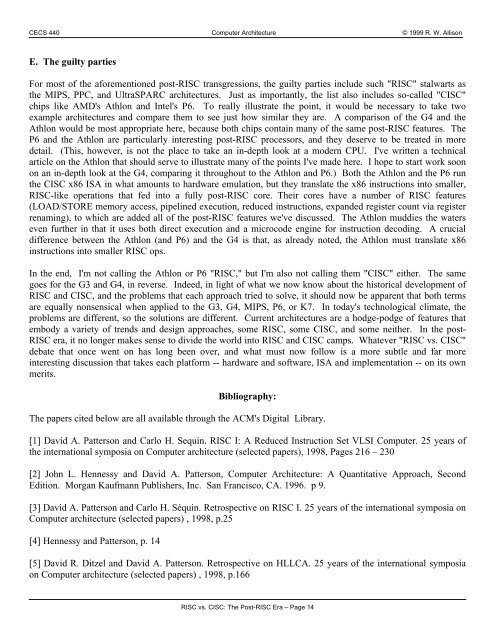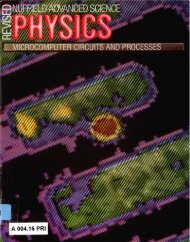RISC vs. CISC
RISC vs. CISC
RISC vs. CISC
You also want an ePaper? Increase the reach of your titles
YUMPU automatically turns print PDFs into web optimized ePapers that Google loves.
CECS 440 Computer Architecture © 1999 R. W. Allison<br />
E. The guilty parties<br />
For most of the aforementioned post-<strong>RISC</strong> transgressions, the guilty parties include such "<strong>RISC</strong>" stalwarts as<br />
the MIPS, PPC, and UltraSPARC architectures. Just as importantly, the list also includes so-called "<strong>CISC</strong>"<br />
chips like AMD's Athlon and Intel's P6. To really illustrate the point, it would be necessary to take two<br />
example architectures and compare them to see just how similar they are. A comparison of the G4 and the<br />
Athlon would be most appropriate here, because both chips contain many of the same post-<strong>RISC</strong> features. The<br />
P6 and the Athlon are particularly interesting post-<strong>RISC</strong> processors, and they deserve to be treated in more<br />
detail. (This, however, is not the place to take an in-depth look at a modern CPU. I've written a technical<br />
article on the Athlon that should serve to illustrate many of the points I've made here. I hope to start work soon<br />
on an in-depth look at the G4, comparing it throughout to the Athlon and P6.) Both the Athlon and the P6 run<br />
the <strong>CISC</strong> x86 ISA in what amounts to hardware emulation, but they translate the x86 instructions into smaller,<br />
<strong>RISC</strong>-like operations that fed into a fully post-<strong>RISC</strong> core. Their cores have a number of <strong>RISC</strong> features<br />
(LOAD/STORE memory access, pipelined execution, reduced instructions, expanded register count via register<br />
renaming), to which are added all of the post-<strong>RISC</strong> features we've discussed. The Athlon muddies the waters<br />
even further in that it uses both direct execution and a microcode engine for instruction decoding. A crucial<br />
difference between the Athlon (and P6) and the G4 is that, as already noted, the Athlon must translate x86<br />
instructions into smaller <strong>RISC</strong> ops.<br />
In the end, I'm not calling the Athlon or P6 "<strong>RISC</strong>," but I'm also not calling them "<strong>CISC</strong>" either. The same<br />
goes for the G3 and G4, in reverse. Indeed, in light of what we now know about the historical development of<br />
<strong>RISC</strong> and <strong>CISC</strong>, and the problems that each approach tried to solve, it should now be apparent that both terms<br />
are equally nonsensical when applied to the G3, G4, MIPS, P6, or K7. In today's technological climate, the<br />
problems are different, so the solutions are different. Current architectures are a hodge-podge of features that<br />
embody a variety of trends and design approaches, some <strong>RISC</strong>, some <strong>CISC</strong>, and some neither. In the post-<br />
<strong>RISC</strong> era, it no longer makes sense to divide the world into <strong>RISC</strong> and <strong>CISC</strong> camps. Whatever "<strong>RISC</strong> <strong>vs</strong>. <strong>CISC</strong>"<br />
debate that once went on has long been over, and what must now follow is a more subtle and far more<br />
interesting discussion that takes each platform -- hardware and software, ISA and implementation -- on its own<br />
merits.<br />
Bibliography:<br />
The papers cited below are all available through the ACM's Digital Library.<br />
[1] David A. Patterson and Carlo H. Sequin. <strong>RISC</strong> I: A Reduced Instruction Set VLSI Computer. 25 years of<br />
the international symposia on Computer architecture (selected papers), 1998, Pages 216 – 230<br />
[2] John L. Hennessy and David A. Patterson, Computer Architecture: A Quantitative Approach, Second<br />
Edition. Morgan Kaufmann Publishers, Inc. San Francisco, CA. 1996. p 9.<br />
[3] David A. Patterson and Carlo H. Séquin. Retrospective on <strong>RISC</strong> I. 25 years of the international symposia on<br />
Computer architecture (selected papers) , 1998, p.25<br />
[4] Hennessy and Patterson, p. 14<br />
[5] David R. Ditzel and David A. Patterson. Retrospective on HLLCA. 25 years of the international symposia<br />
on Computer architecture (selected papers) , 1998, p.166<br />
<strong>RISC</strong> <strong>vs</strong>. <strong>CISC</strong>: The Post-<strong>RISC</strong> Era – Page 14











